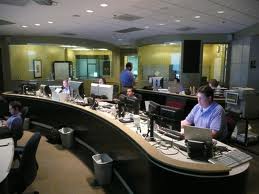 When I tell people I work in IT Operations, I sometimes get a blank stare. While IT Application programmers are well understood, people are a little fuzzier on what an IT Operations department does. To clear up any confusion, here’s my take on what IT Operations is, how it differs from IT Applications, and how IT Operations can be managed in an overall IT department.
When I tell people I work in IT Operations, I sometimes get a blank stare. While IT Application programmers are well understood, people are a little fuzzier on what an IT Operations department does. To clear up any confusion, here’s my take on what IT Operations is, how it differs from IT Applications, and how IT Operations can be managed in an overall IT department.
 If I start with a common source, Wikipedia defines IT Operations as consisting of “…the superset of all processes and services that are both provisioned by an IT staff to their internal or external clients and used by themselves, to run themselves as a business.”
If I start with a common source, Wikipedia defines IT Operations as consisting of “…the superset of all processes and services that are both provisioned by an IT staff to their internal or external clients and used by themselves, to run themselves as a business.”
This is a reasonable definition, but it takes too much thinking. Let’s redefine it by starting with a few simple definitions that should make for a much clearer definition of what IT Operations does.
RELATED: Help Desk Management: What is Level 1, Level 2, and Level 3 Help Desk support?
Redefining IT Operations
First, we start with what IT Operations is not.
IT Operations is not IT Applications
IT Operations generally does not deal in programming activities. Going from that, we can refine IT Ops as follows:
IT Operations generally covers everything (all IT functions) outside of Application programming and management
By doing this,the IT Operations and IT Applications relationship becomes a Venn diagram that doesn’t overlap, like this.
This is interesting but unrealistic, as there are many areas where IT Operations and IT Applications do intersect. Generally speaking, IT applications is usually in charge of business analysis, design, coding, testing, and custom software deployment and IT Operations is not. But it’s also important to realize that the two functions overlap in the following areas:
- Off-the-shelf software installation and configuration for business applications support
- Database maintenance – Applications and users maintain the database from a database integrity viewpoint; Operations maintains it from an efficiency and processing viewpoint (cleaning up deleted records, reindexing, creating new indexes and views, backing up, etc.)
- Troubleshooting applications
- Monitoring application performance and issues, and alerting emergency resources when a problem occurs (call trees)
- Telecom configuration for communication with business partners, customers, and other entities (ex., FTP, EDI, e-commerce connections for ordering, copying data between servers, etc.)
- Help Desk – Help Desk duties are sometimes split between an IT Applications Help Desk and an IT Operations Help Desk
- Job scheduling management to insure that all required jobs run according to schedule on all platforms
- Financial system auditing – Insuring financials are secured according to regulatory and security requirements (including Sarbanes-Oxley, HIPAA, auditing, and other requirements)
- Integrating specialized equipment with particular applications – This may include scanners, industrial printers, display terminals, thin clients, tablets, cell phones, etc.
If we take the common areas into account, our IT Operations-IT Applications diagram morphs into this:
The shaded area here defines the first part of what IT Operations does. To complete the list, we have to add those areas that IT Operations is responsible for that have nothing to do with IT Applications.
In general, the rest of IT Operations tasks fall into three areas: Computer Operations & Help Desk; Network Infrastructure; and Server and Device Management. So here’s what our Venn Diagram looks like, if I break down IT Operations into these areas.
 Here’s a list of what IT Operations deals with that fall into these three sub-areas.
Here’s a list of what IT Operations deals with that fall into these three sub-areas.
Network Infrastructure
- Infrastructure – All networking functions for internal and external IT communications (router, hubs, firewalls, DNS servers, file servers, load balancing, etc.)
- Telecommunications – Managing and configuring all internal and external communication lines so that customers, employees, vendors, and other interested parties can access applications.
- Port management – Opening and closing ports on the firewall to allow the network to communicate with outside servers.
- Security – Insuring the network is secured only to authorized users and to prevent/counter attacks from outside sources
- Remote access to the network for users – Setting up access from outside the network using techniques such as VPN, two-factor authentication, etc.
- Internal telephone system management – Managing the company phone system
- Monitoring network health and alerting network personnel when an issue occurs with network resources (including storage, services such as email or file servers, application servers, communications, etc.)
Server & Device Management
- Server management for applications and infrastructure – Set up configuration, maintenance, upgrades, patching, repair, etc.
- Network and individual storage management to insure that all applications have access to the storage requirements they need for disk, memory, backup, and archiving
- Email and file server configuration and folder setup and authorization – I classify this as a separate area because outside of order taking & fulfillment and customer service, email and file server management are two of the most important IT functions in a company
- PC provisioning – Acquisition, configuration, management, break/fix, applications installation & configuration, upgrades of company approved desktop and laptop devices
- Mobile device and cell phone telecommunications management – Provisioning, assigning, managing, cell phone contracts, and phone numbers. Provisioning for mobile device approved by the organization. Providing for BYOD access to the network.
- Desktop, laptop, and mobile device software application licensing and management
Computer Operations & Help Desk
- Data Center management – Management of the physical locations where the equipment resides, including floor space, electricity, cooling, battery backups, etc.
- Help Desk management – Level 1 support for IT Operations with responsibility for escalating issues to and following up on issues with Level 2 and Level 3 support.
- User provisioning – Creation and authorization of user profiles on all systems. Also includes changes to user profiles and the procedure for deleting old user profiles
- Auditing – Proving to outside entities (corporate auditors, the government, regulatory agencies, business partners, etc) that your network is correctly configured and secured
- Communications with network users when a major incident occurs impacting network services
- High availability and disaster recovery – Providing capabilities to insure your application servers and network can function in the event of a disaster
- Backups management- Instituting and running daily, weekly, monthly, yearly backups to insure data can be recovered, if needed
- Computer operations – Printing and distributing reports, invoices, checks, other outputs from a production systems, such as an IBM i
- Maintain, manage, and add to the IT Infrastructure Library (ITIL) for the organization
Items All Areas are responsible for
- Vendor and contract management – Responsible for working with vendors, negotiations, and paying bills for all hardware, software, and services employed by the network and its applications
- Outside contractor management – Working with outside resources that provide services for the network
- Break/fix and repairing problems that occur
- Project management and deployment – Deploying improvements and fixes to the network and applications infrastructure
Organizing your IT Operations department
The IT Operations sub-areas defined above along with shared functions between IT Operations and IT Applications, are one way of organizing the operations group in an overall IT organization. Different IT organizations will organize their departments in different ways, depending on their own needs and resources. The idea behind documenting these functions is to provide a template for Data Center planning, organization and talent acquisition.
It’s also important to note that whether you run an in-house Data Center, run your IT environment in a managed or hosted environment, or move your applications to the cloud, an IT Operations department will have to deal with these functions, regardless of where your physical network is located. Most of these functions are universal; it’s only their implementation that varies in different environments.
So what’s a good definition of IT Operations, anyway?
When I put it all together, here’s the definition of IT Operations I like best.
IT Operations is responsible for the smooth functioning of the infrastructure and operational environments that support application deployment to internal and external customers, including the network infrastructure; server and device management; computer operations; IT infrastructure library (ITIL) management; and help desk services for an organization.
This isn’t to say this is the only way to define IT Operations (see the Wikipedia definition at the beginning of the article for another example). It’s merely the definition I feel most comfortable with based on my own experience, and how I would think about organizing an IT Operations department if I were building that department from scratch.
Please feel free to comment on this article and suggest future changes. I will be modifying this information in the coming months. Please post any feedback as a comment at the bottom of this article or send me an email at joe@joehertvik.com.










This is absolutely the best outline of IT Operations I have ever read. Thank you for a great post.
As a former IT Operations Manager at a large company, I agree with Jonathon. Great analysis.
Thanks, John. Appreciate the feedback.
thank you for the awesome post joe
Joe – Could you define what differentiates IT Sustain activities from IT Operations, from a hosting infrastructure perspective? I manage a IT Ops Storage and BUR and always struggle with what tasks would be defined as sustain vs. operational.
Great job, Joe. Well-written and clear, and very thorough. I’ve been in IT Operations Management for over 30 years & was pleased to read this.
Thanks for this, Joe.
Thanks Joe for this detailed explanation on IT operations.
Appreciate if you can suggest any certification programs for IT operations team other than ITIL service operation.